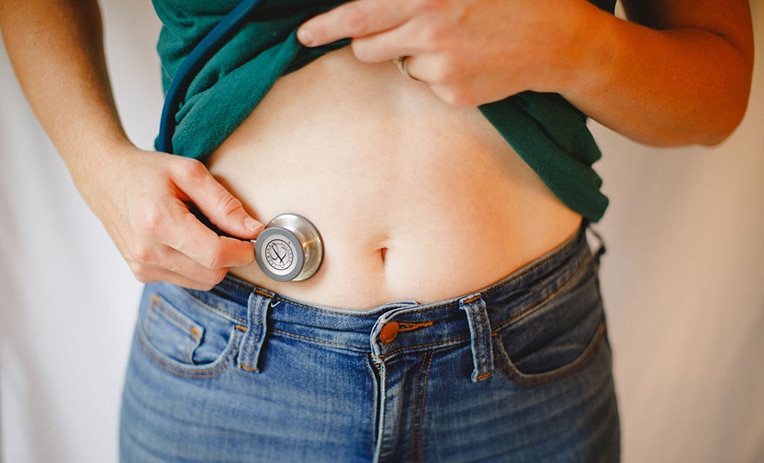
Bringing a new life into the world is an extraordinary journey filled with wonder, anticipation, and, possibly, a touch of anxiety. Whether you’re already planning to start a family or are just considering the possibility, the preparation for pregnancy is a transformative chapter in every woman’s life. It’s a time when taking proactive steps to optimize your body becomes paramount, setting the stage for a healthy and joyful pregnancy.
So what can you do to ensure your body is in the best possible condition to get pregnant? As a naturopathic doctor, I believe it’s vital to adopt a truly holistic approach in your preparation. This means going beyond the mainstream advice of merely avoiding alcohol and smoking.
It’s about nurturing your body and creating a harmonious environment for you and your future child. Here are my top 5 recommendations to help you prepare your body for conception.
How to Prepare Body for Conception
1. Identify and Address Hormonal Imbalances
It probably doesn’t surprise you to know that hormones play a significant role in your ability to get pregnant. However, many women find these critical compounds frustrating, especially when they suspect that a hormonal imbalance may be the root cause of their struggle to conceive.
Hormonal imbalances occur when your body has too little or too much of a specific hormone or hormones in circulation. And because hormones can affect others, having one out of balance can cause a domino effect.
Here are some of the major players that impact your ability to conceive:
- Thyroid hormones, most notably triiodothyronine (T3) and thyroxine (T4)
- Prolactin
- Anti-Müllerian hormone
- Follicle-stimulating hormone
- Luteinizing hormone
- Progesterone
There are two main ways hormonal imbalances can affect a woman’s ability to conceive:
- Ovulatory dysfunction is an ovarian problem characterized by abnormal, irregular, or absent ovulation. Horme-related abnormalities, such as polycystic ovarian syndrome (PCOS) and thyroid disorders, can affect the regularity of ovulation. When there is no egg to fertilize, a pregnancy cannot happen.
- A short luteal phase can also cause fertility problems. Progesterone controls the length of the luteal phase, which lasts about 13 to 14 days on average. When the luteal phase becomes shorter due to abnormal progesterone levels, a fertilized embryo may not be able to implant in the womb.
Unfortunately, many women don’t know they have a hormonal imbalance until they try to conceive. And it’s nearly impossible to diagnose it on your own. Any of the following signs warrant an evaluation by your doctor:
- Irregular menstrual cycles
- PCOS
- Hypothyroidism
- Autoimmune thyroid disorders
- Adrenal imbalances
- Progesterone deficiencies
The good news is that most women who have hormonal imbalances can get pregnant with the right treatment. So, while it’s crucial to get yourself checked out, don’t panic.
2. Optimize Your Nutrition With a Fertility Supportive Diet
There’s no doubt about it – what a woman eats affects her fertility.
But if you’ve ever ventured into the world of nutrition, you’ve likely come across mountains of conflicting information and opinions. What researchers can agree on, though, is that an anti-inflammatory preconception diet is likely to improve your fertility outcome.1 An anti-inflammatory diet is one that emphasizes:
- Reducing the intake of sugars and processed foods
- Increasing consumption of nutrient-dense whole foods and components such as high-quality proteins, healthy fats, fish, and fresh vegetables.
As a women’s health specialist who has worked with hundreds of women to overcome their fertility issues, I highly recommend considering the Mediterranean diet for its anti-inflammatory benefits.
You’ve likely heard about all the wonders of the Mediterranean diet. Numerous scientific studies have reported on the seemingly endless health benefits of the Mediterranean diet, including improving the risk for:
- Type 2 diabetes2
- Dementia3
- Cardiovascular disease4
- Depression5
- Certain types of cancer6,7
- Osteoporosis8
- Obesity9
It’s no wonder the U.S. News & World Report ranked the Mediterranean diet as the best overall diet for the 6th year in a row in 2023.
In 2022, researchers reported that adherence to anti-inflammatory diets like the Mediterranean diet improves fertility, success of assisted reproductive technology, and sperm quality in men.10
To summarize, changing your pattern of eating to something healthier like the Mediterranean diet is a non-intrusive, affordable way that could improve your overall health and your chances of conceiving.
But what exactly is the Mediterranean diet?
Generally speaking, the modern definition of the Mediterranean diet is a dietary pattern that emphasizes the following:
- Vegetables
- Healthy fats like olive oil
- Whole grains, nuts, seeds, and legumes
- High-quality protein
- Moderate amounts of fish
- Fresh fruits
The Mediterranean diet is essentially a fresh, real-food diet. If you reduce your intake of highly processed foods, your body will reward you with better health and fertility.
3. Adopt a Sustainable, Active Lifestyle
Exercise before and during pregnancy has become a hot topic in recent years.
Let’s set the record straight: Generally, physical activity is perfectly safe and beneficial for healthy women trying to conceive.
An active lifestyle may help you conceive by:
- Reducing stress
- Managing weight
- Strengthening bones and muscles
- Improving immune health
- Increasing blood flow and circulation
- Improving mental health
One study followed 17,544 women without a history of infertility for eight years as they tried to become pregnant or became pregnant. The purpose of the study was to see whether diet and other lifestyle practices, such as exercise, impacted fertility.
The result? Regular physical activity, weight control, and better adherence to a healthy diet were associated with a 69% lower risk of ovulatory disorder infertility. These findings suggest that diet and exercise can have a positive influence on fertility in healthy women.11
An active lifestyle is also beneficial for women undergoing in vitro fertilization (IVF). In one study, researchers asked 121 undergoing non-donor IVF embryo transfer to evaluate their physical activity during the preceding year. They found that the women who had an active lifestyle were more likely to have a favorable IVF outcome.12
But you may have been told that vigorous exercise – defined as one that causes considerable sweating and shortness of breath – is actually bad for women trying to conceive.
An early study compared hormonal markers and menstrual cycle characteristics of women who ran an average of 32 kilometers per week with sedentary women. And the findings were alarming. For example, 58% of the regular runners in this study were found to have menstrual cycle abnormalities versus just 9% of sedentary women. Other hormonal alterations seen in the runners were similar to those observed in amenorrheic athletes, suggesting that high-intensity exercise may have a negative effect on women’s fertility.13
While other studies have since presented similar findings, an article published in 2015 provided some encouragement for highly active women wishing to continue their exercise regimen. The researchers showed that the detrimental effects of vigorous exercise could be countered by increased caloric intake.14 In other words, you should plan to eat the same number of calories you lost during a high-intensity exercise session.
As always, it’s still best to check with your ob-gyn to determine whether it’s okay for you to exercise and which exercises are safe for you.
4. Optimize Your Gut Microbiome
When it comes to reproductive health, most of the focus tends to be on hormonal balance, lifestyle choices, and genetics.
But emerging research suggests another – and rather unexpected – player: the gut microbiome.
Your gut microbiome is a community of bacteria, viruses, fungi, and protozoa in your digestive tract. These microbes have co-evolved with their hosts over time, and we’ve just begun to scratch the surface of their extensive influence on our health.
This means that while a balanced gut microbiome contributes to optimal health, disturbances in its homeostasis can lead to the development of diseases, including female reproductive health disorders.15,16
One possible mechanism behind the gut microbiome’s influence on female reproductive health appears to be via the gut microbiome-estrogen axis.
This functional link was first noted almost 40 years ago when researchers found that antibiotic use lowered estrogen levels in women.17 Your gut microbiome secretes an enzyme called beta-glucuronidase, which produces unbound estrogen in the gastrointestinal tract. Active estrogen is then able to bind to estrogen receptors, which in turn influences downstream estrogen-dependent processes.18
The close functional connection also means that gut dysbiosis – an imbalance in the gut microbiome – could lead to lower levels of circulating estrogens.19 The resulting low-estrogen state increases a woman’s risk of diseases like obesity and cardiovascular diseases.20 On the other hand, high beta-glucuronidase means elevated estrogen levels, which can lead to endometriosis or certain types of cancer.21
Therefore, it’s critical for women to prioritize gut health when trying to conceive.
Consider the following to improve your gut microbiome:
- Lifestyle changes, such as many of the things discussed in this article
- A healthy, whole-food, high-fiber diet
- Probiotic and prebiotic supplements
- Calcium d-glucarate to reduce circulating estrogens
- Reduction of xenoestrogen exposure
5. Learn About Physiological Birth
When you think about someone giving birth, you probably imagine her in a hospital room, hooked up to monitors, and receiving drugs to reduce pain or induce labor. The image of a woman undergoing major surgery to give birth may also come to mind.
This is all normal – isn’t it?
It’s actually far from normal. Furthermore, there are potential serious short- and long-term risks with delivering a baby via a c-section, such as postoperative infections, placental complications, and chronic pain.
The fact is, a healthy woman with a normal pregnancy should be able to go through labor and deliver a baby vaginally without medical intervention. This is the innate biological capacity of a woman, something that shouldn’t be forced or driven by technology.
In 2013, the American College of Nurse-Midwives, the Midwives Alliance of North America, and the National Association of Certified Professional Midwives released a consensus statement on their vision of “normal physiological birth.” They stated, “A normal physiological labor and birth is one that is powered by the innate human capacity of the woman and the fetus.”22
According to the statement, a normal physiologic childbirth is characterized by the following:23
- Spontaneous onset and progression of labor
- Biological and psychological conditions that promote effective labor
- Vaginal birth
- Physiological blood loss
- Optimal newborn transition via skin-to-skin contact with the mother during the postpartum period
- Early initiation of breastfeeding
Anything that disrupts this normal physiological process, such as induction of labor, can increase the likelihood of negative consequences for the mother and/or the infant.
I am by no means saying all women should try to give birth without medical intervention; rather, I believe that all healthy women should learn about physiological birth. Please discuss with your doctor(s) to determine whether physiological birth is right for you.
Prepare Your Body for Pregnancy With a Naturopathic Women’s Health Specialist in Boston
Deciding to have a baby is a huge, exciting step. But the excitement can quickly turn into stress and frustration for many women with no answers in sight.
As a naturopathic women’s health specialist, I’ve worked with hundreds of women across the country to prepare their bodies for conception and have a successful pregnancy. I can help you, too.
If you’re struggling to conceive and want to learn how to optimize your health naturally, schedule a free consultation with me today.
- https://www.mdpi.com/2072-6643/14/19/3914
- https://www.ncbi.nlm.nih.gov/pmc/articles/PMC7468821/
- https://pubmed.ncbi.nlm.nih.gov/36889921/
- https://www.amjmed.com/article/S0002-9343(11)00410-4/fulltext
- https://ijbnpa.biomedcentral.com/articles/10.1186/s12966-021-01227-3
- https://pubmed.ncbi.nlm.nih.gov/27014505/
- https://www.ncbi.nlm.nih.gov/pmc/articles/PMC6770822/
- https://www.ncbi.nlm.nih.gov/pmc/articles/PMC7915719/
- https://pubmed.ncbi.nlm.nih.gov/34423871/
- https://www.mdpi.com/2072-6643/14/19/3914
- https://pubmed.ncbi.nlm.nih.gov/17978119/
- https://pubmed.ncbi.nlm.nih.gov/24524834/
- https://pubmed.ncbi.nlm.nih.gov/12519874/
- https://www.ncbi.nlm.nih.gov/pmc/articles/PMC4281686/
- https://www.ncbi.nlm.nih.gov/pmc/articles/PMC5785832/
- https://jme.bioscientifica.com/view/journals/jme/69/3/JME-21-0238.xml
- https://pubmed.ncbi.nlm.nih.gov/6231418/
- https://jme.bioscientifica.com/view/journals/jme/69/3/JME-21-0238.xml
- https://pubmed.ncbi.nlm.nih.gov/23259758/
- https://jme.bioscientifica.com/view/journals/jme/69/3/JME-21-0238.xml
- https://jme.bioscientifica.com/view/journals/jme/69/3/JME-21-0238.xml
- https://www.ncbi.nlm.nih.gov/pmc/articles/PMC3647729/
- https://www.ncbi.nlm.nih.gov/pmc/articles/PMC3647729/




